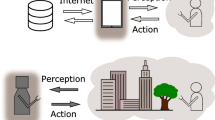Abstract
One of the most difficult tasks in robotics is to replace one human-operator by an intelligent, autonomous and emotional humanoid robot for conducting various types of real-world tasks. To perform a pre-specified task, the optimal design of a proposed humanoid robot is being frozen after carrying out its kinematics and dynamic analysis. Based on this optimized design, the robot is fabricated, and its performances are tested in the Laboratory. If it is found to be satisfactory, it is then used in the real field. Let us assume that the developed humanoid robot is facing a few undesirable disturbances due to some changes in the working environment. For example, one humanoid robot working as a soldier in the real field suddenly faces some un-expected rough terrains to be negotiated by maintaining its dynamic balance and consuming minimum energy. This paper deals with the issues related to negotiating these sudden changes in the environment and varying loads with the help of its AI-assisted adaptive vision system, multi-sensors data fusion system, motion and gait planning schemes, controller, and so on. After summarizing this study, some scopes for the future study have also been suggested. To make an intelligent humanoid robot capable of negotiating the varying situations, it should be equipped with AI-assisted vision system, adaptive motion and gait planners, adaptive and robust controller, and others.








Similar content being viewed by others
References
Albus JS (1991) Outline for a theory of intelligence. IEEE Trans Syst Man Cybern 21(3):473–509
Das AK, Pratihar DK (2019), A new Bonobo Optimizer (BO) for real-parameter optimization, Proc. of IEEE TENSYMP Conference, Kolkata, India.
Gupta P, Pratihar DK, Deb K (2023) Analysis and optimization of gait cycle of 25 dof robot using particle swarm optimization and genetic algorithms. Int J Humanoid Rob. https://doi.org/10.1142/S0219843623500111
Ha Q, Nguyen QH, Rye DC, Durrant-Whyle HF (2001) Fuzzy sliding-mode controllers with applications. IEEE Trans Indus Electron 48(1):38–46
Hasan MA, Mishra RK, Singh S (2019) Speed control of DC motor using adaptive neuro-fuzzy inference system based PID controller, Proc. Of 2nd International Conference on Power Energy Environmental and Intelligent Control (PEEIC), G. L. Bajaj Institute of Technology and Management, Greater Noida, UP, India, Oct. 18–19, 2019.
Holland JH (1975) Adaptation in natural and artificial systems. The University of Michigan Press, USA
Huan TT, Van Kien C, Anh HP, Nam NT (2018) Adaptive gait generation for humanoid robot using evolutionary neural model optimized with modified differential evolution technique. Neurocomputing 3(320):112–20
Ivakhnenko AG (1971) Polynomial theory of complex systems. IEEE Trans Syst Man Cybern 4:364–378
Jahanshahi H, Jafarzadeh M, Sari NN, Pham VT, VanHuynh V, Nguyen XQ (2019) Robot motion planning in an unknown environment with danger space. Electronics 8:201
Karpathy A, Abbeel P, Brockman G, Chen P, Cheung V, Duan Y, Goodfellow I, Kingma D, Ho J, Houthooft R, Salimans T, Schulman J, Sutskever I, Zaremba W (2016) Generative models. OpenAI.
Kashyap AK, Parhi DR, Muni MK, Pandey KK (2020) A hybrid technique for path planning of humanoid robot NAO in static and dynamic terrains. Appl Soft Comput 96:106581
Kennedy J, Eberhart R (1995), Particle Swarm Optimization, Proc. of IEEE International Conference on Neural Networks, Perth, Australia, pp. 1942–1948.
Kohonen T (1995) Self-Organizing Maps. Springer-Verlag, Heidelberg
Landau YD (1979) Adaptive control: the model reference approach. Marcel Dekker, New York
Mahapatra A, Roy SS, Pratihar DK (2019) Multi-body dynamic modeling of multi-legged robots. Springer Pte Ltd. https://doi.org/10.1007/978-981-15-2953-5_4
Majumder S, Pratihar DK (2018) Multi-sensor data fusion through fuzzy clustering and predictive tools. Exp Syst Appl. https://doi.org/10.1016/j.eswa.2018.04.026
Matthews D, Spielberg A, Rus D, Bongard J (2023) Efficient automatic design of robots. PNAS 120(41):e2305180120. https://doi.org/10.1073/pnas.2305180120
McCulloch WS, Pitts W (1943) A logical calculus of the ideas immanent in nervous activity. Bull Math Biophys 5:115–133
Omar BAA, Haikal AYM, Areed FFG (2011) Design adaptive neuro-fuzzy speed controller for an elctro-mechanical system. Ain Shams Eng J 2(2):99–107
Pratihar DK (2014) Soft computing: fundamentals and applications. Narosa Publishing House Pvt. Ltd., New-Delhi
Pratihar DK (2017) Fundamentals of robotics. Narosa Publishing House, New-Delhi
Pratihar DK, Jain LC (2010) Intelligent autonomous systems: foundations and applications. Springer-Verlag, Berlin
Rajendra R (2012), Modeling and Simulations of Robotic Systems Using Soft Computing, PhD Thesis, IIT Kharagpur, India.
Shojaei K, Shahri AM, Tabibian, b, (2013) Design and implementation of an inverse dynamics controller for uncertain nonholonomic robotic systems. J Intell Rob Syst 71:65–83
Tao C, Xue J, Zhang Z, Cao F, Li C, Gao H (2021) Gait optimization method for humanoid robots based on parallel comprehensive learning particle swarm optimization algorithm. Front Neurorobot 14:600885
Vikas, Parhi DR, Kashyap AK (2023) Humanoid robot path planning using memory-based gravity search algorithm and enhanced differential evolution approach in a complex environment. Exp Syst Appl 215(1):119423
Vukobratovic M, Frank AA, Juricic D (1970) On the stability of biped locomotion. IEEE Trans Biomed Eng 17(1):25–36
Vundavilli PR, Pratihar DK (2010) Dynamically balanced optimal gaits of a ditch-crossing biped robot. Robot Auton Syst 58:349–361
Vundavilli PR, Pratihar DK (2011) Near-optimal gait generations of a two-legged robot on rough terrains using soft computing. Robot Comput Integr Manuf 27:521–530
Website: https://www.ibm.com/ibm/history/ibm100/us/en/icons/deepblue/
Website: ttps://vegavid.com/blog/?s=The+power+of+AI
Zadeh LA (1965) Fuzzy Sets. Inf Control 8:338–353
Ziegler JG, Nichols NB (1942) Optimum settings for automatic controllers. Trans ASME 64:759–768
Author information
Authors and Affiliations
Corresponding author
Ethics declarations
Conflict of interest
The author has no conflict of interest with others.
Additional information
Publisher's Note
Springer Nature remains neutral with regard to jurisdictional claims in published maps and institutional affiliations.
Rights and permissions
Springer Nature or its licensor (e.g. a society or other partner) holds exclusive rights to this article under a publishing agreement with the author(s) or other rightsholder(s); author self-archiving of the accepted manuscript version of this article is solely governed by the terms of such publishing agreement and applicable law.
About this article
Cite this article
Pratihar, D.K. AI-Assisted Intelligent Humanoid Robot. Trans Indian Natl. Acad. Eng. (2024). https://doi.org/10.1007/s41403-024-00468-5
Received:
Accepted:
Published:
DOI: https://doi.org/10.1007/s41403-024-00468-5




